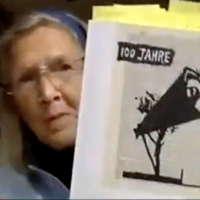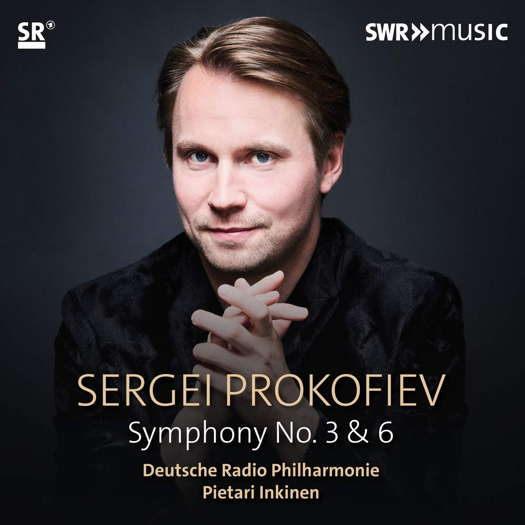- experimental
- Nicolae Brânduş
- Halida Dinova
- Antonio Membrado
- Jacques Offenbach
- Friedrich Witt
- Trondheim
- Taiwan Philharmonic
 SPONSORED: CD Spotlight. Well Realized - Varda Kotler and Israel Kastoriano - recommended by Geoff Pearce.
SPONSORED: CD Spotlight. Well Realized - Varda Kotler and Israel Kastoriano - recommended by Geoff Pearce.
All sponsored features >>
 VIDEO PODCAST: Discussion about Bernard Haitink (1929-2021), Salzburg, Roger Doyle's Finnegans Wake Project, the English Symphony Orchestra, the Chopin Competition Warsaw, Los Angeles Opera and other subjects.
VIDEO PODCAST: Discussion about Bernard Haitink (1929-2021), Salzburg, Roger Doyle's Finnegans Wake Project, the English Symphony Orchestra, the Chopin Competition Warsaw, Los Angeles Opera and other subjects.

Audacious Symphonic Language
Prokofiev's Symphonies Nos 3 and 6
played by the Deutsche Radio Philharmonie,
heard by GERALD FENECH
'Pietari Inkinen and his German ensemble are on top form and both symphonies receive compelling interpretations full of cohesive and dynamic playing.'
During his brilliant and often tormented compositional career, Sergei Prokofiev (1891-1953) wrote seven symphonies but, of these, only the First and Fifth feature regularly in the concert hall. This should not be, as all of these pieces inhabit a world of their own and reflect, in audacious symphonic language, the personality and times of the composer. Indeed, each symphony is a veritable tour de force in its dynamic content and unique orchestration.
The works on this superb recording seem to originate from two different planets, but each one has a fascination all of its own. First let's delve into the Third. In 1927 Prokofiev finished his opera The Fiery Angel, a love story about the knight Ruprecht and Renata set during the Reformation. Renata is haunted by dark visions and pushed to participating in occult practices, eventually landing her in front of the Inquisition, while Ruprecht invokes the powers of Mephisto to quench his sexual desires. All this drama is played against the backdrop of a convent of nuns who in the end become possessed by 'The Fiery Angel'.
Listen — Prokofiev: Moderato (Symphony No 3 in C minor)
(track 1, 0:01-0:26) © 2018 SWR Media Services GmbH,
2020 Naxos Deutschland Musik & Video Vertriebs-GmbH :
Despite working on the piece for seven years, Prokofiev never managed to stage the opera, and it was only in 1955, two years after the composer's death, that this hugely dramatic stage-work saw the light of day. His hopes dashed, Prokofiev decided to compose a suite and present his music to an audience. Encouraged by his composer-friend Nikolay Myaskovsky he set about this new task, but no sooner had he started on his choice of music that Prokofiev soon realised that the proposed suite could be transformed into a symphony, and so the Third was born.
Listen — Prokofiev: Andante (Symphony No 3 in C minor)
(track 2, 1:25-2:17) © 2018 SWR Media Services GmbH,
2020 Naxos Deutschland Musik & Video Vertriebs-GmbH :
It is a piece permeated by a terrifying sense of anger and defiance and a prime example of how to successfully deal with failure. Still, the symphony has not really captured the public's affections, probably due to its complex nature, despite a lyrical slow movement, a dazzling third movement in the form of a devilish 'scherzo' and an almost unhinged final movement which starts as a sinister march and builds to a massive climax of overwhelming power.
Listen — Prokofiev: Andante mosso (Symphony No 3 in C minor)
(track 4, 5:20-6:20) © 2018 SWR Media Services GmbH,
2020 Naxos Deutschland Musik & Video Vertriebs-GmbH :
The history of the Sixth is totally different. When Prokofiev presented his Sixth Symphony in 1947 he was enjoying the peak of his career, but in this work the composer wanted to convey the pain of a survivor of the losses sustained in the War. Characteristics of this piece are the conclusions of its three movements: the first movement, whose three themes have three different tempi, the 'largo' with its variety of melodies that are built up as well as the pointedly humorous finale ending with a coda that only presents mere fragments of the respective main theme.
Listen — Prokofiev: Vivace (Symphony No 6 in E flat minor)
(track 7, 11:26-12:06) © 2018 SWR Media Services GmbH,
2020 Naxos Deutschland Musik & Video Vertriebs-GmbH :
The Symphony was a success and the fact that he was awarded the 'Stalin' prize shows that the culture bosses also held him in high esteem. Come January 1948 and everything changed. The Zhdanov decree banned all composers with 'formalistic' tendencies and Prokofiev found himself in hot water. No surprise then that the Sixth Symphony disappeared from concert programmes. Prokofiev went on to compose more works until his death in 1953, but he did not manage to write another piece comparable to the Sixth.
Listen — Prokofiev: Vivace (Symphony No 6 in E flat minor)
(track 6, 14:13-15:06) © 2018 SWR Media Services GmbH,
2020 Naxos Deutschland Musik & Video Vertriebs-GmbH :
Pietari Inkinen and his German ensemble are on top form and both symphonies receive compelling interpretations full of cohesive and dynamic playing. Indeed, the conductor's keen alertness to the many subtle details of these scores borders on the super sensitive. Outstanding in every way and an addition of quality to the Prokofiev discography. Sound and presentation are superb.
Copyright © 7 June 2020
Gerald Fenech,
Gzira, Malta

CD INFORMATION - PROKOFIEV: SYMPHONIES NOS 3 AND 6
FURTHER INFORMATION - SERGEI PROKOFIEV
FURTHER INFORMATION - SWR MUSIC


